MEF 插件式开发之 WPF 初体验
MEF 在 WPF 中的简单应用
MEF 的开发模式主要适用于插件化的业务场景中,C/S 和 B/S 中都有相应的使用场景,其中包括但不限于
ASP.NET MVC、ASP WebForms、WPF、UWP等开发框架。当然,DotNet Core也是支持的。
在上篇文章中,笔者大致讲述如果在控制台程序中创建一个简单的 MEF 应用程序。如果有读者不太清楚,可点击 MEF 插件式开发 - 小试牛刀 进行查看。在本篇博文中,笔者将创建一个简单的 WPF 程序来做一些 MEF 的相关小实验。
首先,我们创建一个工程,工程的目录结构如下图所示

- MefSample:WPF主程序,用来负责程序相关初始化
- MefSample.Core:类库,核心接口库,来用约束相关插件的导出接口
- MefSample.Plugin1:用户控件库,插件1,某一独立具体的业务模块
- MefSample.Plugin2:用户控件库,插件2,某一独立具体的业务模块
- MefSample.Service:类库,某一具体服务的实现
我们在相应模块中添加相应代码,来构建一个简单的 MEF 示例程序。
在 MefSample.Core 中,我们创建一个 IView 的接口,用于插件的导出约束,示例代码如下所示
[Description("视图接口")]
public interface IView
{
}
然后分别在 MefSample.Plugin1 和 MefSample.Plugin2 创建一个 UserControl ,并修改相应的后台代码
MefSample.Plugin1
[Export(typeof(IView))]
public partial class MainView : UserControl,IView
{
public MainView()
{
InitializeComponent();
}
}
MefSample.Plugin2
[Export(typeof(IView))]
public partial class MainView : UserControl,IView
{
public MainView()
{
InitializeComponent();
}
}
加载插件
模块加载分两种:实时加载 和 延迟加载,针对模块数量少,内存消耗小的话,我们可以采用常规的加载方式,但是若工程项目较复杂,模块数较多的话,延迟加载是一种不错的选择方式,这里分别针对这两种加载方式进行简单的代码描述
- 常规加载
在主程序 MefSample 中,我们可以采用之前的加载方式来加载所有的插件,示例代码如下所示
public partial class MainWindow : Window
{
private CompositionContainer container = null;
public MainWindow()
{
InitializeComponent();
}
protected override void OnContentRendered(EventArgs e)
{
var dir = new DirectoryInfo(AppDomain.CurrentDomain.BaseDirectory);
if (dir.Exists)
{
var catalog = new DirectoryCatalog(dir.FullName, "*.dll");
container = new CompositionContainer(catalog);
try
{
container.ComposeParts(this);
}
catch (CompositionException compositionEx)
{
Console.WriteLine(compositionEx.ToString());
}
IEnumerable<IView> plugins = container.GetExportedValues<IView>();
foreach (var plugin in plugins)
{
this.tab.Items.Add(new TabItem() { Header = plugin.ToString(),Content = plugin });
}
}
base.OnContentRendered(e);
}
protected override void OnClosing(CancelEventArgs e)
{
container?.Dispose();
base.OnClosing(e);
}
}
- 懒加载
要想用到懒加载技术需要借助 Lazy 来实现,稍微将上述代码修改一下就可以了,示例代码如下所示
public partial class MainWindow : Window
{
[ImportMany]
public Lazy<IView>[] plugins { get; set; }
private CompositionContainer container = null;
public MainWindow()
{
InitializeComponent();
}
protected override void OnContentRendered(EventArgs e)
{
var dir = new DirectoryInfo(AppDomain.CurrentDomain.BaseDirectory);
if (dir.Exists)
{
var catalog = new DirectoryCatalog(dir.FullName, "*.dll");
container = new CompositionContainer(catalog);
try
{
container.ComposeParts(this);
}
catch (CompositionException compositionEx)
{
Console.WriteLine(compositionEx.ToString());
}
foreach (var plugin in plugins)
{
this.tab.Items.Add(new TabItem()
{
// 此时 pulugin 对象还未创建,执行 plugin.Value 才会创建该对象
Header = plugin.ToString(),
Content = plugin.Value
});
}
}
base.OnContentRendered(e);
}
protected override void OnClosing(CancelEventArgs e)
{
container?.Dispose();
base.OnClosing(e);
}
}
获取元数据
有时,单纯地加载一个插件并不能满足我们的业务需求,我们可能还需要获取一些插件中的元数据来进行相应处理,这个时候我们就需要借助 IMetaData 来满足我们的业务场景需求。
首先,我们在 MefSample.Core 创建一个新的接口,定义为 IMetadata,并创建一个与之对应的自定义属性 CustomExportMetadata ,相关示例代码如下所示
/// <summary>
/// 元数据接口
/// 第二种方法可参考:MetadataViewImplementation 方式
/// </summary>
public interface IMetadata
{
[DefaultValue(0)]
int Priority { get; }
string Name { get; }
string Description { get; }
string Author { get; }
string Version { get; }
}
[MetadataAttribute]
[AttributeUsage(AttributeTargets.Class, AllowMultiple = false, Inherited = false)]
public class CustomExportMetadata : ExportAttribute, IMetadata
{
public int Priority { get; private set; }
public string Name { get; private set; }
public string Description { get; private set; }
public string Author { get; private set; }
public string Version { get; private set; }
public CustomExportMetadata() : base(typeof(IMetadata))
{
}
public CustomExportMetadata(int priority) : this()
{
this.Priority = priority;
}
public CustomExportMetadata(int priority, string name) : this(priority)
{
this.Name = name;
}
public CustomExportMetadata(int priority, string name, string description) : this(priority, name)
{
this.Description = description;
}
public CustomExportMetadata(int priority, string name, string description, string author) : this(priority, name, description)
{
this.Author = author;
}
public CustomExportMetadata(int priority, string name, string description, string author, string version) : this(priority, name, description, author)
{
this.Version = version;
}
}
然后为我们的每个插件打上相应标签
MefSample.Plugin2
[Export(typeof(IView))]
[CustomExportMetadata(1,"Plugin 1","这是第一个插件","hippiezhou","1.0")]
public partial class MainView : UserControl,IView
{
public MainView()
{
InitializeComponent();
}
}
MefSample.Plugin2
[Export(typeof(IView))]
[CustomExportMetadata(2, "Plugin 2", "这是第二个插件", "hippiezhou", "1.0")]
public partial class MainView : UserControl, IView
{
public MainView()
{
InitializeComponent();
}
}
最后,修改我们的主程序
public partial class MainWindow : Window
{
[ImportMany]
public Lazy<IView,IMetadata>[] Plugins { get; set; }
private CompositionContainer container = null;
public MainWindow()
{
InitializeComponent();
}
protected override void OnContentRendered(EventArgs e)
{
var dir = new DirectoryInfo(AppDomain.CurrentDomain.BaseDirectory);
if (dir.Exists)
{
var catalog = new DirectoryCatalog(dir.FullName, "*.dll");
container = new CompositionContainer(catalog);
try
{
container.ComposeParts(this);
}
catch (CompositionException compositionEx)
{
Console.WriteLine(compositionEx.ToString());
}
foreach (var plugin in Plugins)
{
this.tab.Items.Add(new TabItem()
{
//获取元数据
Header = plugin.Metadata.Name,
Content = plugin.Value
});
}
}
base.OnContentRendered(e);
}
protected override void OnClosing(CancelEventArgs e)
{
container?.Dispose();
base.OnClosing(e);
}
}
依赖注入
最后说一下关于依赖注入的问题,在上篇博文中我们简单叙述了什么是 IOC。谈到控制反转就不得不提一下依赖注入了。在本次实验中,笔者通过往 Plugin2 插件注入一个简单服务来进一步理解。
首先,我们在 MefSample.Core 中创建一个服务接口 IService,示例代码如下所示
[Description("服务接口")]
public interface IService
{
void QueryData(int numuber, Action<int> action);
}
其次,我们在 MefSample.Service 中实现一个相应的服务 DataService,示例代码如下所示
[Description("具体服务")]
[Export(nameof(DataService),typeof(IService))]
public class DataService : IService
{
public void QueryData(int numuber, Action<int> action)
{
action(numuber * 100);
}
}
最后,我们在 MefSample.Plugin2 的模块构造函数中注入一个服务 IService 类型的服务,示例代码如下所示
[Export(typeof(IView))]
[CustomExportMetadata(2, "Plugin 2", "这是第二个插件", "hippiezhou", "1.0")]
public partial class MainView : UserControl, IView
{
public readonly IService Service;
[ImportingConstructor]
public MainView([Import("DataService")]IService service)
{
InitializeComponent();
Service = service;
Service.QueryData(10, sum => { this.tb.Text = sum.ToString(); });
}
}
当我们重新编译程序项目并运行的话,会发现插件二模块的界面上会显示 1000。这里需要注意的是,你也可以不通过构造函数来注入服务,而是以属性的方式。但是我个人不建议这么做,因为它并不能很好的阐释了 DI 。这里建议读者朋友阅读一下 Artech 大叔发布的相关系列文章,确实相当精彩,很是值得阅读。
总结
MEF 对初学者来说可能不是很好理解,但是多写几个 Demo 试验几次就好了。如果后续还有时间的话,我会与大家简单分享一下 Prism 框架的使用。这里分享几个 Github 地址给大家
MEF 插件式开发之 WPF 初体验的更多相关文章
- MEF 插件式开发之 DotNetCore 初体验
背景叙述 在传统的基于 .Net Framework 框架下进行的 MEF 开发,大多是使用 MEF 1,对应的命名空间是 System.ComponentModel.Composition.在 Do ...
- MEF 插件式开发之 DotNetCore 中强大的 DI
背景叙述 在前面几篇 MEF 插件式开发 系列博客中,我分别在 DotNet Framework 和 DotNet Core 两种框架下实验了 MEF 的简单实验,由于 DotNet Framewor ...
- Android插件化开发之OpenAtlas生成插件信息列表
上一篇文章.[Android插件化开发之Atlas初体验]( http://blog.csdn.net/sbsujjbcy/article/details/47446733),简单的介绍了使用Atla ...
- MEF 插件式开发 - WPF 初体验
原文:MEF 插件式开发 - WPF 初体验 目录 MEF 在 WPF 中的简单应用 加载插件 获取元数据 依赖注入 总结 MEF 在 WPF 中的简单应用 MEF 的开发模式主要适用于插件化的业务场 ...
- MEF 插件式开发 - 小试牛刀
原文:MEF 插件式开发 - 小试牛刀 目录 MEF 简介 实践出真知 面向接口编程 控制反转(IOC) 构建入门级 MEF 相关参考 MEF 简介 Managed Extensibility Fra ...
- MEF 插件式开发之 小试牛刀
MEF 简介 Managed Extensibility Framework 即 MEF 是用于创建轻量.可扩展应用程序的库. 它让应用程序开发人员得以发现和使用扩展且无需配置. 它还让扩展开发人员得 ...
- [MEF插件式开发] 一个简单的例子
偶然在博客园中了解到这种技术,顺便学习了几天. 以下是搜索到一些比较好的博文供参考: MEF核心笔记 <MEF程序设计指南>博文汇总 先上效果图 一.新建解决方案 开始新建一个解决方案Me ...
- [转][MEF插件式开发] 一个简单的例子
偶然在博客园中了解到这种技术,顺便学习了几天. 以下是搜索到一些比较好的博文供参考: MEF核心笔记 <MEF程序设计指南>博文汇总 先上效果图 一.新建解决方案 开始新建一个解决方案Me ...
- jQuery插件的开发之$.extend(),与$.fn.extend()
jQuery插件的开发包括两种: 一种是类级别的插件开发,即给jQuery添加新的全局函数,相当于给jQuery类本身添加方法.jQuery的全局函数就是属于jQuery命名空间的函数,另一种 ...
随机推荐
- 分享《机器学习实战基于Scikit-Learn和TensorFlow》中英文PDF源代码+《深度学习之TensorFlow入门原理与进阶实战》PDF+源代码
下载:https://pan.baidu.com/s/1qKaDd9PSUUGbBQNB3tkDzw <机器学习实战:基于Scikit-Learn和TensorFlow>高清中文版PDF+ ...
- QQ网页弹窗
QQ网页弹窗 1.网址:http://shang.qq.com/v3/index.html 2.选推广工具,提示语随便写 3.建一个html 网页,并把代码拷进去. 4.双击网页,就可以打开了.(用E ...
- 将json对象转化成jsonp对象
这个Demo用来检查是否具有唯一性 //检查 /user/check/{param}/{type} @RequestMapping("/check/{param}/{type}") ...
- MyBatis 源码分析 - 内置数据源
1.简介 本篇文章将向大家介绍 MyBatis 内置数据源的实现逻辑.搞懂这些数据源的实现,可使大家对数据源有更深入的认识.同时在配置这些数据源时,也会更清楚每种属性的意义和用途.因此,如果大家想知其 ...
- Java基础--枚举
1.枚举简介 枚举是由一组固定的常量组成的类型,自定义数据类型. 枚举的常量值一定是可列举的有限值.常量值的类型都是public static final. 下面代码中的Gender 是一种自定义的数 ...
- I2C和I2S的区别和使用方法
I2C(Inter-Integrated Circuit)总线是由PHILIPS公司开发的两线式串行总线,用于连接微控制器及其外围设备.是微电子通信控制领域广泛采用的一种总线标准.它是同步通信的一种特 ...
- Pycharm 连接Linux 远程开发
Pycharm 连接Linux 远程开发 在Liunx上安装python3.6(Ubuntu16) 下载Python-3.6.4.tgz 解压 tar -xzvf Python-3.6.4.tgz 进 ...
- Java 架构师+高并发+性能优化+Spring boot大型分布式项目实战
视频课程内容包含: 高级 Java 架构师包含:Spring boot.Spring cloud.Dubbo.Redis.ActiveMQ.Nginx.Mycat.Spring.MongoDB.Zer ...
- odoo开发笔记 -- 翻译机制及导入.po文件
待补充 http://ju.outofmemory.cn/entry/181972
- Apache Commons Digester 二(规则模块绑定-RulesModule、异步解析-asyncParse、xml变量Substitutor、带参构造方法)
前言 上一篇对Digester做了基本介绍,也已经了解了Digester的基本使用方法,接下来将继续学习其相关特性,本篇主要涉及以下几个内容: 规则模块绑定,通过定义一个RulesModule接口实现 ...
